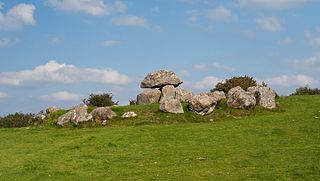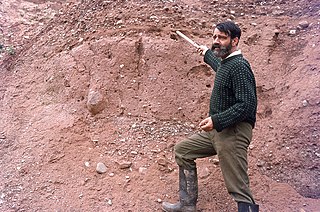Related Research Articles

The Neogene is a geologic period and system that spans 20.45 million years from the end of the Paleogene Period 23.03 million years ago (Mya) to the beginning of the present Quaternary Period 2.58 million years ago. It is the second period of the Cenozoic and the eleventh period of the Phanerozoic. The Neogene is sub-divided into two epochs, the earlier Miocene and the later Pliocene. Some geologists assert that the Neogene cannot be clearly delineated from the modern geological period, the Quaternary. The term "Neogene" was coined in 1853 by the Austrian palaeontologist Moritz Hörnes (1815–1868). The earlier term Tertiary Period was used to define the span of time now covered by Paleogene and Neogene and, despite no longer being recognized as a formal stratigraphic term, "Tertiary" still sometimes remains in informal use.

Paleoethnobotany, or archaeobotany, is the study of past human-plant interactions through the recovery and analysis of ancient plant remains. Both terms are synonymous, though paleoethnobotany is generally used in North America and acknowledges the contribution that ethnographic studies have made towards our current understanding of ancient plant exploitation practices, while the term archaeobotany is preferred in Europe and emphasizes the discipline's role within archaeology.

Carrowmore is a large group of megalithic monuments on the Coolera Peninsula to the west of Sligo, Ireland. They were built in the 4th millennium BC, during the Neolithic. There are thirty surviving tombs, making Carrowmore one of the largest clusters of megalithic tombs in Ireland, and one of the 'big four' along with Carrowkeel, Loughcrew and Brú na Bóinne. Carrowmore is the heart of an ancient ritual landscape which is dominated by the mountain of Knocknarea to the west. It is a protected National Monument.
The Beestonian Stage is an early Pleistocene stage in the geological history of the British Isles. It is named after Beeston Cliffs near West Runton in Norfolk where deposits from this stage are preserved.
The International Union for Quaternary Research (INQUA) was founded in 1928. It has members from a number of scientific disciplines who study the environmental changes that occurred during the glacial ages, the last 2.6 million years. One goal of these investigators is to document the timing and patterns in past climatic changes to help understand the causes of changing climates.
Quaternary science is the subfield of geology which studies the Quaternary Period commonly known as the ice age. The Quaternary Period is a time period that started around 2.58 million years ago and continues today. This period is divided into two epochs – the Pleistocene Epoch and the Holocene Epoch. The aim of Quaternary science is to understand everything that happened during the Pleistocene Epoch and the Holocene Epoch to be able to acquire fundamental knowledge about Earth's environment, ecosystem, climate changes, etc. Quaternary science was first studied during the nineteenth century by Georges Cuvier, a French scientist. Most Quaternary scientists have studied the history of the Quaternary to predict future changes in climate.
Valerie Hall (1946-2016) was a Professor in Palaeoecology at Queen's University Belfast until her retirement in 2010, after which she remained a Professor Emerita. She gained a 2:2 in botany at Queen's University Belfast in 1968 and a PhD in Palaeoecology in 1989. She has produced a number of publications of which the best known may be Flora Hibernica, which she co-wrote along with J. Pilcher and published in 2001.
The Hekla 3 eruption (H-3) c. 1000 BC is considered the most severe eruption of Hekla during the Holocene. It threw about 7.3 km3 of volcanic rock into the atmosphere, placing its Volcanic Explosivity Index (VEI) at 5. This would have caused a volcanic winter, cooling temperatures in the Northern Hemisphere for several years afterwards.

Irish cuisine encompasses the cooking styles, traditions and recipes associated with the island of Ireland. It has developed from antiquity through centuries of social and political change and the mixing of different cultures, predominantly with those from nearby Britain and other European regions. The cuisine is founded upon the crops and animals farmed in its temperate climate and the abundance of fresh fish and seafood from the surrounding waters of the Atlantic Ocean. Chowder, for example, is popular around the coasts. Herbs and spices traditionally used in Irish cuisine include bay leaves, black pepper, caraway seeds, chives, dill, horseradish, mustard seeds, parsley, ramsons, rosemary, sage and thyme.
Wonderwerk Cave is an archaeological site, formed originally as an ancient solution cavity in dolomite rocks of the Kuruman Hills, situated between Danielskuil and Kuruman in the Northern Cape Province, South Africa. It is a National Heritage Site, managed as a satellite of the McGregor Museum in Kimberley. Geologically, hillside erosion exposed the northern end of the cavity, which extends horizontally for about 140 m (460 ft) into the base of a hill. Accumulated deposits inside the cave, up to 7 m (23 ft) in-depth, reflect natural sedimentation processes such as water and wind deposition as well as the activities of animals, birds, and human ancestors over some 2 million years. The site has been studied and excavated by archaeologists since the 1940s and research here generates important insights into human history in the subcontinent of Southern Africa. Evidence within Wonderwerk cave has been called the oldest controlled fire. Wonderwerk means "miracle" in the Afrikaans language.
The Environmental Seismic Intensity scale is a seismic scale used for measuring the intensity of an earthquake on the basis of the effects of the earthquake on the natural environment.

Eduard Meine van Zinderen Bakker was a Dutch-born South African palynologist who made significant contributions to the fields of plant ecology, palynology and palaeo-ecology of Africa.

Russell Coope, also Geoffrey Russell Coope and G. Russell Coope was a Quaternary paleoentomologist and neontologist and a paleoclimatologist specializing in the British Pleistocene. He was an expert and leader in the reconstruction of Quaternary paleoenvironmental conditions from fossil beetles. The relatively young age of his fossils allowed Coope to explore construction sites for fossils, in addition to geological field sites.
Ann Grace Wintle is a British geophysicist and is the pioneer of luminescence dating, by increasing the precision of existing methods and maximum age of fossil the method is able to reliably date. She also set up the NERC luminescence dating facility in Aberystwyth, Wales.
Amy Bogaard FBA is a Canadian archaeologist and Professor of Neolithic and Bronze Age Archaeology at the University of Oxford.
The School of Archaeology is an academic department of the University of Oxford comprising the Institute of Archaeology and the Research Laboratory for Archaeology and the History of Art (RLAHA), and is part of Oxford's Social Sciences Division. The school was created in 2000 when the two existing departments were combined under this umbrella. Both sub-departments retain separate directors, who report to the head of the School of Archaeology, who is replaced every three years.
Glynis Eleanor Jones FBA is a British archaeobotanist, who is Professor of Archaeology at the University of Sheffield.
Zenobia Jacobs is a South African-born archaeologist and earth scientist specialising in geochronology. She is a professor at the University of Wollongong, Australia.
Meriel McClatchie is an archaeologist specialising in archaeobotany. She is an associate professor at University College Dublin.

Agriculture in Ireland began during the neolithic era, when inhabitants of the island began to practice animal husbandry and farming grains. Principal crops grown during the neolithic era included barley and wheat.
References
- ↑ "Professor Nicki Whitehouse". Plymouth University.
- ↑ "INQUA - HABCOM people". INQUA.
- ↑ "Quaternary International - Editorial Board". Elsevier journals - Quaternary International.
- ↑ "Journal of Archaeological Science: Reports - Editorial Board". Elsevier journals - Journal of Archaeological Science: Reports.
- ↑ "Newsletter of the Association for Environmental Archaeology Latest edition: Newsletter 94 November 2006". Association for Environmental Archaeology.
- ↑ "Reconstructing the 'Wildscape'". University of Plymouth.
- ↑ Whitehouse, Nicki; Schulting, Rick; McLaughlin, Rowan. "INSTAR—Cultivating Societies".
- ↑ "CELTIC CONNECTIONS AND CRANNOGS: A NEW STUDY OF LAKE SETTLEMENTS ACROSS THE IRISH SEA". University of Glasgow.
- ↑ "FRAGSUS Research Team". Queens University Belfast. 28 April 2020.